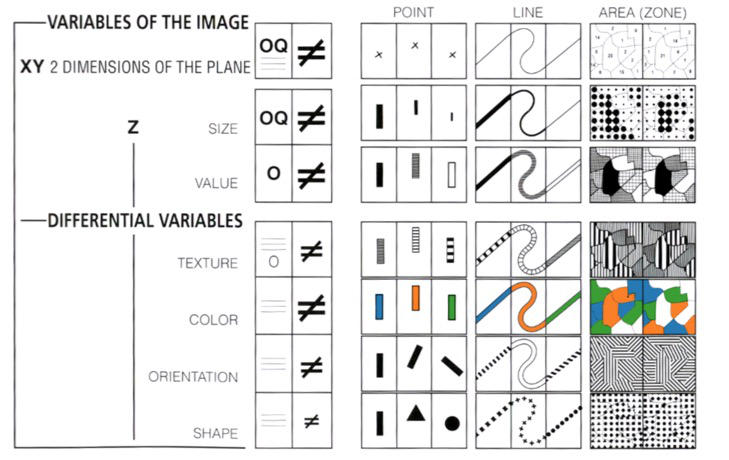d3-scale
Table of Contents
- Continuous Scales
continuous(value)continuous.invert(value)continuous.domain([domain])continuous.range([range])continuous.rangeRound([range])continuous.clamp(clamp)continuous.interpolate(interpolate)continuous.ticks([count])continuous.tickFormat([count[, specifier]])continuous.nice([count])continuous.copy()
- Scales
- Introducing d3-scale
- Sequential Scales vs Diverging Scales
d3-scale-chromatic
Continuous Scales
- linear, power, log, identity, time, or sequential color
- Following
continuousstands for the returned object from one of the functions liked3.scaleLinear()
continuous(value) reference
var color = d3.scaleLinear()
.domain([10, 100])
.range(["brown", "steelblue"]);
color(20); // "#9a3439"
color(50); // "#7b5167"continuous.invert(value) reference
- Inversion is useful for interaction, say to determine the data value corresponding to the position of the mouse.
continuous(continuous.invert(y))approximately equalsy
var x = d3.scaleLinear()
.domain([10, 130])
.range([0, 960]);
x.invert(80); // 20
x.invert(320); // 50continuous.domain([domain]) reference
- If
domainis specified, sets the scale’s domain to the specified array of numbers. - If the elements in the given array are not numbers, they will be coerced to numbers.
var color = d3.scaleLinear()
.domain([-1, 0, 1])
.range(["red", "white", "green"]);
color(-0.5); // "rgb(255, 128, 128)"
color(+0.5); // "rgb(128, 192, 128)"continuous.range([range]) reference
- Unlike the
domain, elements in the given array need not be numbers - Any value that is supported by the underlying
interpolatorwill work
continuous.rangeRound([range]) reference
- Same as
.range(), but used3.interpolateRoundinstead of the default interpolator, which will round the resulting value to the nearest integer.
Equivalent to:
continuous.clamp(clamp) reference
- If
clampis specified, enables or disables clamping accordingly. - If clamping is disabled and the scale is passed a value outside the domain, the scale may return a value outside the range through extrapolation.
var x = d3.scaleLinear()
.domain([10, 130])
.range([0, 960]);
x(-10); // -160, outside range
x.invert(-160); // -10, outside domain
x.clamp(true);
x(-10); // 0, clamped to range
x.invert(-160); // 10, clamped to domaincontinuous.interpolate(interpolate) reference
- The default interpolator may reuse return values.
- If the range values are objects, then the value interpolator always returns the same object, modifying it in-place.
A common reason to specify a custom interpolator is to change the color space of interpolation. For example, to use HCL:
continuous.ticks([count]) reference
- Returns approximately
countrepresentative values from the scale’s domain.
continuous.tickFormat([count[, specifier]]) reference
var x = d3.scaleLinear()
.domain([-1, 1])
.range([0, 960]);
var ticks = x.ticks(5),
tickFormat = x.tickFormat(5, "+%");
ticks.map(tickFormat); // ["-100%", "-50%", "+0%", "+50%", "+100%"]continuous.nice([count]) reference
- Extends the
domainso that it starts and ends on nice round values. - This method typically modifies the scale’s domain, and may only extend the bounds to the nearest round value.
continuous.copy()
Scales
d3.scaleLinear()
d3.scalePow()
d3.scaleLog()
d3.scaleIdentity()
d3.scaleTime()
d3.scaleSequential(interpolator)
d3.scaleDiverging(interpolator)
d3.scaleQuantize()
d3.scaleQuantile()
d3.scaleThreshold()
d3.scaleOrdinal([range])
d3.scaleBand()
d3.scalePoint()
Introducing d3-scale tutorial

A scale is a function that takes an abstract value of data, such as the mass of a diamond in carats, and returns a visual value such as the horizontal position of a dot in pixels. With two scales (one each for x and y), we have the basis for a scatterplot.
var x = d3.scaleLinear()
.domain(d3.extent(data, function(d) { return d.carat; }))
.range([0, width]);
var y = d3.scaleLinear()
.domain(d3.extent(data, function(d) { return d.price; }))
.range([height, 0]);Sequential Scales vs Diverging Scales discussion
- Both are similar to continuous scales
- However, unlike continuous scales, the output range is fixed by its interpolator and not configurable.
Examples of these types are as follows:
- Sequential

- Diverging
Like
d3.scaleSequential, but requires that the domain has three values, and maps to a diverging interpolator such asd3.interpolateRdBu.
You can use these scales with interpolators provided by d3-scale-chromatic: